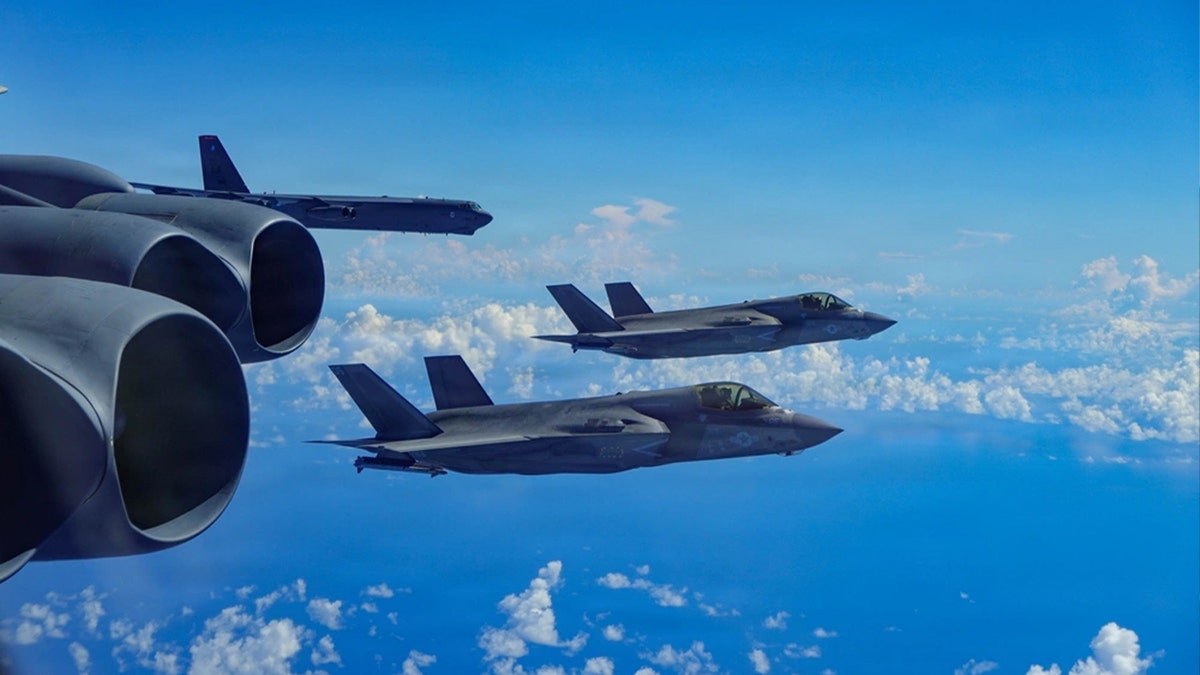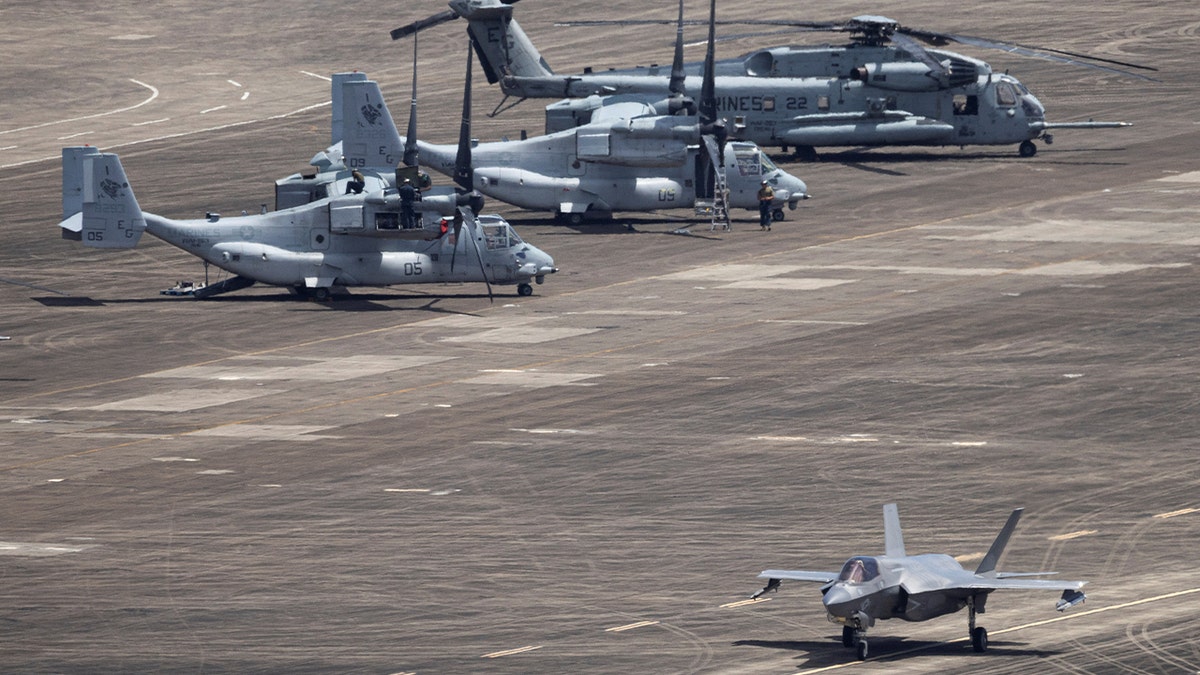NEWYou can now listen to Fox News articles!
The United States has significantly increased its military presence across the Caribbean under U.S. Southern Command, deploying bombers, warships, and Marines as part of an expanded campaign targeting drug-trafficking and so-called “narco-terrorist” networks operating near Venezuela.
In addition to seven strikes on boats believed to be carrying narcotics, the Trump administration has built up thousands of troops in the region.
War Secretary Pete Hegseth this month announced the creation of a new counter-narcotics Joint Task Force operating near Southern Command, saying it was established “to crush the cartels, stop the poison, and keep America safe.” The task force will coordinate air, maritime, and special-operations missions across the region — marking the largest U.S. military effort in the Caribbean in decades.
U.S. Air Force B-52H Stratofortress bombers and Marine Corps F-35B Lightning II fighters recently conducted a bomber attack demonstration over the region — a show of force captured in Defense Department imagery. For four hours on Wednesday, B-52s from Barksdale Air Force Base in Louisiana patrolled near Venezuela’s coast in a display of military might aimed at Venezuelan dictator Nicolás Maduro.
TRUMP UNLEASHES US MILITARY POWER ON CARTELS. IS A WIDER WAR LOOMING?
President Donald Trump directed a deadly strike on a suspected drug-running boat, War Secretary Pete Hegseth said. (SecWar/X)
At least seven U.S. Naval warships and one nuclear submarine are believed to be patrolling the region.
The USS Iwo Jima Amphibious Ready Group is also operating in the Caribbean Sea. Ship spotters photographed the flagship USS Iwo Jima (LHD-7) off the coast of Ponce, Puerto Rico, on Friday. The group includes USS Fort Lauderdale (LPD-28), USS San Antonio (LPD-17) and the 22nd Marine Expeditionary Unit, based at Camp Lejeune and Marine Corps Air Station New River, N.C. The 22nd MEU comprises Marine Medium Tiltrotor Squadron 263 (Reinforced), Combat Logistics Battalion 26 and Battalion Landing Team 3/6.
Three U.S. Navy guided-missile destroyers — USS Jason Dunham (DDG-109), USS Gravely (DDG-107), and USS Stockdale (DDG-106) — are currently deployed in the Caribbean, joined by the guided-missile cruiser USS Lake Erie (CG-70) and the littoral combat ship USS Wichita (LCS-13), which has been operating near Cuba.
Open-source reporting indicates that a U.S. nuclear-powered attack submarine has been deployed near Venezuela, although the exact number of nuclear vessels and their precise locations have not been confirmed by the Pentagon.
WAR DEPARTMENT LAUNCHES NEW COUNTER-NARCOTICS TASK FORCE UNDER TRUMP DIRECTIVE TO CRUSH CARTELS
In Puerto Rico, the U.S. has deployed ten F-35 fighter jets and at least three MQ-9 Reaper drones, transforming the island into a key logistics and surveillance hub for operations in the region. Reuters imagery from Aguadilla, Puerto Rico, shows the drones staged for use.
Recent photos also show that Naval Station Roosevelt Roads, a major U.S. facility closed in 2004, has been reactivated. Satellite images and on-site photos reveal aircraft and personnel operating from the base, including at least one AC-130J Ghostrider gunship equipped with Hellfire missiles parked at José Aponte de la Torre Airport, which serves the installation.
Special-operations aviation has increased as well. In early October, MH-6 “Little Bird” light-attack helicopters — typically used by U.S. Army Special Operations Forces — and MH-60M Black Hawks were spotted training off the coast of Trinidad and Tobago, according to images first published by The Washington Post.
The Pentagon has not detailed how long the buildup will last, but a New York Times report estimates about 10,000 U.S. troops are currently operating in the theater — the largest American presence in the region in decades.
U.S. defense officials have linked the deployments to ongoing counter-narcotics and counter-terrorism missions tied to recent strikes on vessels accused of trafficking drugs from Venezuela. The moves come as tensions escalate following Colombia’s claim that one of the U.S. strikes killed a fisherman, not a trafficker — an accusation the White House has denied.
Analysts say the combination of heavy bombers, stealth fighters, Marines, and Navy surface combatants underscores a shift from law-enforcement interdiction to a broader show of force aimed at deterring state-linked trafficking networks.

A U.S. Air Force B-52H Stratofortress bomber assigned to the 2nd Bomb Wing, integrates with a U.S. Marine Corps F-35B Lightning II aircraft assigned to the Marine Fighter Attack Squadron 225, in the U.S. Southern Command area. (U.S. Air Force)
“This is a posture we haven’t seen in the Caribbean since the early 2000s,” said one defense analyst familiar with U.S. operations in the region. “It’s clearly meant to send a message — not just to traffickers, but to governments accused of enabling them.”
Experts generally agree the U.S. buildup does not suggest preparations for all-out war.
Mark Cancian, a senior defense adviser at the Center for Strategic and International Studies, told Fox News Digital that such a campaign would require between 50,000 and 100,000 U.S. troops — far more than the roughly 10,000 currently in theater.
“What I think they’ve put in place is the capability to launch strikes at either the cartels or the Maduro regime,” Cancian said. “If I had to bet, it’s probably against the cartels — but I wouldn’t rule out something against the regime.”
That limited but flexible posture reflects what some experts describe as a modern form of coercive diplomacy.

A U.S. Marine Corps F-35 fighter jet taxies on the tarmac past U.S. Marine Corps Ospreys and helicopters are now parked at the former Roosevelt Roads military base in Ceiba, Puerto Rico, which had been closed for decades. (Ricardo Arduengo/Reuters)
“It sort of looks like we’re in the throes of a 21st-century version of gunboat diplomacy,” said Brandan Buck, a foreign policy analyst at the Cato Institute. “The Trump administration is doing what it can to force some sort of transition [of] power — out of Maduro’s hands and into someone else’s — without a classic invasion.”
CLICK HERE TO DOWNLOAD THE FOX NEWS APP
Ryan Berg, director of the Americas Program at the Center for Strategic and International Studies, said the current deployment gives Washington strike options without committing to a major ground war.
“The force posture currently in the southern Caribbean is consonant with the potential for precision strikes using Tomahawk missiles or other weapons, but without risking the lives of U.S. service personnel,” Berg said.
Original News Source Link – Fox News
Running For Office? Conservative Campaign Consulting – Monthly Rates!
